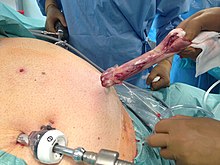Sleeve stomach
Under a gastric tube or stomach of a hose formation (English: sleeve gastrectomy) refers to an operation technique from the spectrum of bariatric surgery that is a reduction in the stomach volume. According to the S3 guideline "Surgery of obesity", the sleeve stomach is one of the recognized standard techniques and is therefore only possible if conservative therapy options have been exhausted.
Operation principle and effects
The principle of the operation is that a longitudinal gastric resection along the great curvature of the stomach reduces the stomach volume by around 80-90%. The amount of food is reduced accordingly, which is why it is referred to as a restrictive surgical procedure. In addition to reducing the amount of food, neuro-humoral mechanisms of action are discussed, as measurable changes in the plasma level of various gastrointestinal hormones (e.g. ghrelin ) occur after the operation . As a rule, a reduction in obesity of around 70–80% is achieved after around 1–2 years. Since the technique of gastric sleeve formation has only been standardized in recent years, no final statement can yet be made with regard to the long-term results. The favorable influence on obesity-associated comorbidities (e.g. diabetes mellitus II, hypertension, sleep apnea syndrome) is comparable to the results of the Roux-en-Y gastric bypass surgery. It must be assumed that there is a permanent need for vitamin B12 substitution , as after other gastric resections .
Surgical technique and complications
The operation is performed under general anesthesia using the so-called minimally invasive technique. The stomach is separated from the large mesh and the connections to the spleen along the great curvature to just below the esophagus with an ultrasound dissector. The gastric resection itself is performed with staple cutting instruments along a calibration tube placed close to the lesser curvature. After the resection, a leak test is usually carried out by injecting fluid (100–150 ml) into the gastric tube (via a gastric tube). The resected part of the stomach is removed using a retrieval bag, followed by the ex situ volume measurement. The operation takes about an hour and the inpatient stay is limited to about 2–4 days if the course is uncomplicated. Complications in the early postoperative course may arise. a. from secondary bleeding, suture leaks (leakage, insufficiency), thrombosis and embolism with a frequency of about 1–2%.
Current rating
Sleeve gastric surgery has gained enormous importance in the last 10 years and has expanded the range of surgical treatment options for extremely overweight. In terms of the frequency of the procedure, gastric sleeve surgery is now well ahead of gastric bypass (Federal Statistical Office 2012: gastric sleeve 3351 versus 3157 gastric bypass). One advantage over the Roux-en-Y gastric bypass surgery is that no bowel diversion is required and therefore this procedure is e.g. B. for patients with a chronic inflammatory bowel disease Crohn's disease or intestinal adhesions is more suitable. Furthermore, the absorption of medication is not disturbed. However, the irreversible loss of a large part of the stomach is a disadvantage. The gastric sleeve surgery is also suitable as a revision surgery after gastric band implantation.
See also
swell
- Guideline for Obesity Surgery. Association of the Scientific Medical Societies in Germany (AWMF). Retrieved December 25, 2011.
- RA Weiner: Obesity surgery: surgical technique - complication management - aftercare, Urban & FischerVerlag, 2009, p. 79 ff., ISBN 3437230255
- M. Büsing, M. Utech, J. Halter, et al .: Sleeve stomach formation in the treatment of morbid obesity study results and first experiences with the transvaginal hybrid NOTES technique. The surgeon . 82 (8), 675-683, 2011.
- Richard Daikeler, Götz Use, Sylke Waibel: Diabetes. Evidence-based diagnosis and therapy. 10th edition. Kitteltaschenbuch, Sinsheim 2015, ISBN 978-3-00-050903-2 , p. 124.
- MM Hutter, BD Schirmer, DB Jones et al. First Report from the American College of Surgeons Bariatric Surgery Center Network, May 26, 2013 (CEST) Laparoscopic Sleeve Gastrectomy has Morbidity and Effectiveness Positioned Between the Band and the Bypass. Annals of Surgery 254 (3), 2011
- MD'Hondt, S. Vanneste, H. Pottel et al .: Laparoscopic sleeve gastrectomy as a single-stage procedure for the treatment of morbid obesity and the resulting quality of life, resolution of comorbidities, food tolerance, and 6-year weight loss . Surg. Endosc. 25 (8), 2498-504, 2011
- R. Peterli, RE Steinert, B. Wölnerhanssen et al .: Metabolic and hormonal changes after laparoscopic Roux-en-Y Gastric Bypass and Sleeve Gastrectomy: a randomized, prospective trial. Whether it. Surg. 22, 740-748, 2012
- O. Martini: Bariatric surgery in Germany & European quality of care in comparison. 6th Obesity Symposium 2013, Norderstedt 21. – 22. February 2013
- http://www.aerzteblatt.de/nachrichten/49874/Schlauchmagen-beoben-Typ-2-Diabetes-mellitus
- M. Utech, H. Shaheen, J. Halter, R. Riege, A. Knapp, E. Wolf, M. Büsing: Sleeve stomach formation as revision surgery after gastric band failure. In: Zentralblatt für Chirurgie - Journal for general, visceral, thoracic and vascular surgery. 139, 2014, p. 79, doi : 10.1055 / s-0032-1328213 .
- http://www.derwesten.de/region/rhein_ruhr/recklinghaeuser-spezialisten-verhelfen-zu-kleinerem-magen-id8504320.html


